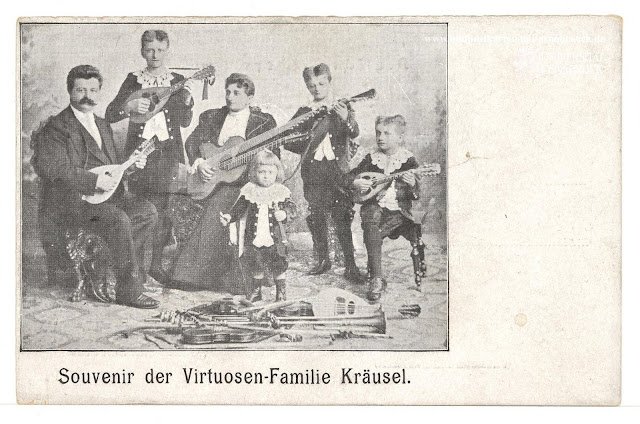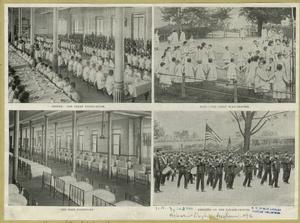Most photographs like this one emphasize the variety of instruments, or the number of children, or both. String instruments are just as varied as brass band instruments, and suggest a more refined musical repertoire. The formal white tie and tails suggest a professional class too. And as always, the youngest child is the star attraction.
This photo postcard is nicely dated Sunday Oct.31, 1909 and provides a printed name of Th. Kräusel, likely Theodor Kräusel.
On the back are the names Edward, Kalle, Ernst, & self. Could it be the mother's or the father's writing? Who else but parents would not bother with a spouse's name? Presumably Edward is the older boy in the back with a cello, next to sister Kalle on cittern, and Ernst in front holding a violin.
The advent of the picture postcard proved a useful new convenience for marketing a musical group like this. There are hundreds of similar musical bands in German and Austrian postcards of this period. This one might even be a first printing saved by Herr Kräusel.
Unfortunately the name Kräusel with its ümlaut offers too many German spelling variants, so I have been unable to find any records on this family. Without knowing their precise background, they may have come from almost anywhere in central Europe.
But I have found more of their photos.
This larger cabinet card size photograph shows two more brothers, but no sister. Along the bottom is printed the same Virtuosen-Familie Th. Kräusel and penciled on the back is:
Zur Freundlicher Erinnerung von Nan Kräusel
For Friendly Remembrance from Nan Kräusel.
A younger family is here with wonderful costumes that have lost their colors to the sepia-tone. If the first date is correct, this photo is perhaps 1902-4, but mother Nan certainly ages. No doubt from the trials of managing such a large band. For Friendly Remembrance from Nan Kräusel.
The photographer is Alfred B. Nilson, Helsingborg which is in Sweden so perhaps there is a Swedish connection. Many Germanic names cross over the complicated boundaries of 19th Century Europe, which makes finding good identity matches very challenging. Or maybe this was taken on tour.
And finally an even older image from the Historische Bildpostkarten Collection from the University of Osnabrück. This was one family band that worked hard on music promotion. And haircuts too.
Imagine traveling in 1900 with steamer trunks full of of instruments, music, costumes and of course the children. Maybe the slower pace balanced out the challenges of railway timetables, bad hotels, and poor roads. Did they perform at hotels or beer gardens? Were they playing for strictly German-speaking audiences or was their music tailored for Danish, Swedish, or even Hungarian tastes?
The string instruments include violins, a violincello, mandolins, a cittern, and the Harp Guitar which was a favorite instrument of German folk ensembles of this era. It has a fretted neck for playing complex chords and an unfretted neck for bass strings played separately in the manner of a harp. There are many kinds of Harp Guitars using different arrangements for strings, necks, and sound box, but it was probably used to accompany the voice. Did the children sing too?
There are also some woodwind instruments, some herald trumpets, and a few percussion too, including a kind of xylophone.
But the reason that this is a unique musical group is found in the first photo. The arrangement on the floor has two unusual instruments crossed on top of two wooden xylophones: an oboe (L) and a Heckelphone (R) with its characteristic side holes in the bell. The oboe is exceptional enough in photographs but the Heckelphone is beyond rare. An obscure member of the oboe family, it was invented by the Wilhelm Heckel GmbH in the 1880s after a suggestion by Richard Wagner for a stronger bass oboe for his operas. Wagner had already "invented" the Wagner Tuba to cope with the special demands for a bass horn in his immense opera productions. This was a similar concept of reinforcing the bass timbre in the double reed instruments: the oboe and the bassoon. Few orchestra musicians today have ever seen or heard a Heckelphone, and usually its part is played by a
Here you can see the full consort of the oboe family from small Musette (bottom) to largest Heckelphone (top), which is an octave lower than the standard oboe ( 2nd from bottom). A modern orchestra typically has two oboes and and English horn. The Heckel company, famous for its bassoons, never completed the design of the Heckelphone in Wagner's lifetime, and the first instrument was only finished in 1905. Richard Strauss used it first for his opera Salome and later Elektra, and An Alpine Symphony. Gustav Holst scored for
Because it is such a very uncommon instrument, there is a Heckelphone List of every single instrument that has been made and that reaches to only 148. In the first decade of the 20th century only 29 were produced, and Herr Kräusel has one at his feet! Could he be an oboist in an opera orchestra who premiered this odd bass instrument in one of Strauss's operas?
 |
| Arthur Grossman Univ. of Washington |
In January, 2001, Music Professor Arthur Grossman of the University of Washington presented a special Heckelphone Concert. His photo from the university magazine shows what an ungainly instrument it is. Click the link for the story of how he acquired his Heckelphone.
But how did the Virtuosen Familie Kräusel get their instrument? Certainly only a professional oboe player would know of such a thing. Theodor Kräusel probably put in a special order to the Heckel factory. At this time there were hundreds of opera houses around the German and Austro-Hungarian Empires, but only a few of them could stage the grand operas of Strauss. Herr Kräusel surely must have played in one of them.
I can not imagine the Heckelphone providing an accompaniment to a medley of German children's songs, but I can imagine that great mustache wrapped around the little double reed. His children must have laughed.

















